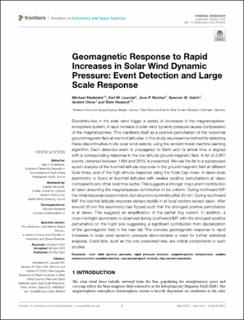| dc.contributor.author | Madelaire, Michael | |
| dc.contributor.author | Laundal, Karl Magnus | |
| dc.contributor.author | Reistad, Jone Peter | |
| dc.contributor.author | Hatch, Spencer Mark | |
| dc.contributor.author | Ohma, Anders | |
| dc.contributor.author | Haaland, Stein Egil | |
| dc.date.accessioned | 2023-03-13T12:31:44Z | |
| dc.date.available | 2023-03-13T12:31:44Z | |
| dc.date.created | 2022-08-29T13:23:49Z | |
| dc.date.issued | 2022 | |
| dc.identifier.issn | 2296-987X | |
| dc.identifier.uri | https://hdl.handle.net/11250/3057955 | |
| dc.description.abstract | Discontinuities in the solar wind trigger a variety of processes in the magnetosphere-ionosphere system. A rapid increase in solar wind dynamic pressure causes compression of the magnetosphere. This manifests itself as a positive perturbation of the horizontal ground magnetic field at low/mid latitudes. In this study we present a method for detecting these discontinuities in situ solar wind data by using the random forest machine learning algorithm. Each detected event is propagated to Earth and its arrival time is aligned with a corresponding response in the low latitude ground magnetic field. A list of 3,867 events, detected between 1994 and 2019, is presented. We use the list in a superposed epoch analysis of the low/mid latitude response in the ground magnetic field at different local times, and of the high latitude response using the Polar Cap index. A dawn-dusk asymmetry is found at low/mid latitudes with weaker positive perturbations at dawn compared to any other local time sector. This suggests a stronger ring current contribution at dawn assuming the magnetopause contribution to be uniform. During northward IMF the initial response is asymmetric, but returns to symmetry after 30 min. During southward IMF the low/mid latitude response decays rapidly in all local sectors except dawn. After around 30 min the asymmetry has flipped such that the strongest positive perturbation is at dawn. This suggests an amplification of the partial ring current. In addition, a noon-midnight asymmetry is observed during southward IMF with the strongest positive perturbation on the night side suggesting a significant contribution from dipolarization of the geomagnetic field in the near tail. The complex geomagnetic response to rapid increases in solar wind dynamic pressure demonstrates a need for further statistical analyses. Event lists, such as the one presented here, are critical components in such studies. | en_US |
| dc.language.iso | eng | en_US |
| dc.publisher | Frontiers | en_US |
| dc.rights | Navngivelse 4.0 Internasjonal | * |
| dc.rights.uri | http://creativecommons.org/licenses/by/4.0/deed.no | * |
| dc.title | Geomagnetic Response to Rapid Increases in Solar Wind Dynamic Pressure: Event Detection and Large Scale Response | en_US |
| dc.type | Journal article | en_US |
| dc.type | Peer reviewed | en_US |
| dc.description.version | publishedVersion | en_US |
| dc.rights.holder | Copyright 2022 The Author(s) | en_US |
| dc.source.articlenumber | 904620 | en_US |
| cristin.ispublished | true | |
| cristin.fulltext | original | |
| cristin.qualitycode | 1 | |
| dc.identifier.doi | 10.3389/fspas.2022.904620 | |
| dc.identifier.cristin | 2046733 | |
| dc.source.journal | Frontiers in Astronomy and Space Sciences | en_US |
| dc.relation.project | Norges forskningsråd: 300844 | en_US |
| dc.identifier.citation | Frontiers in Astronomy and Space Sciences. 2022, 9, 904620. | en_US |
| dc.source.volume | 9 | en_US |

